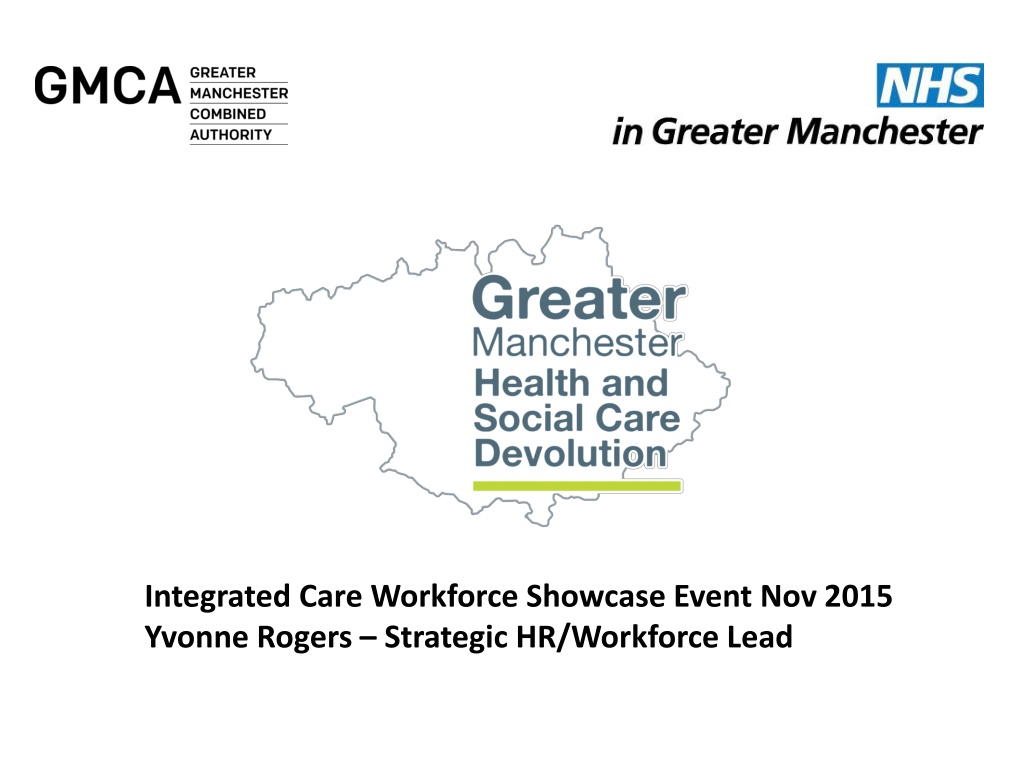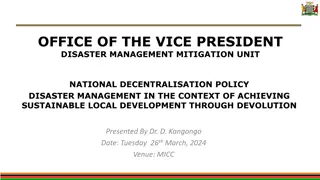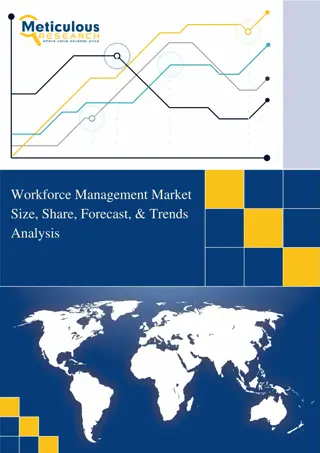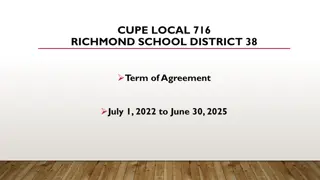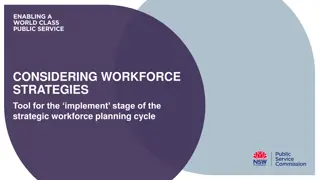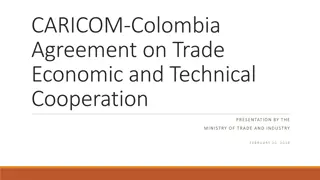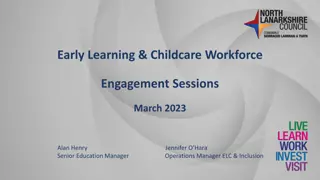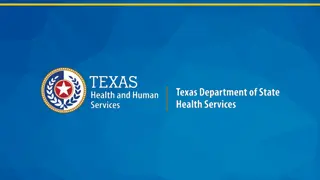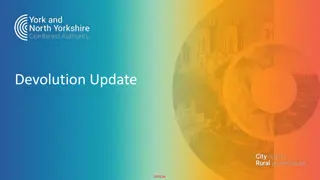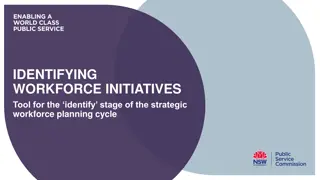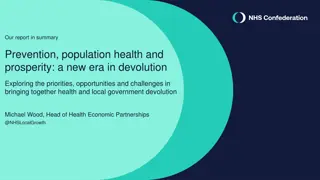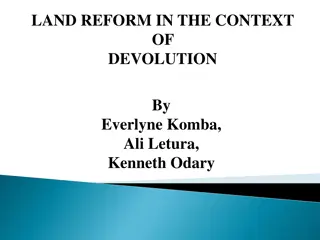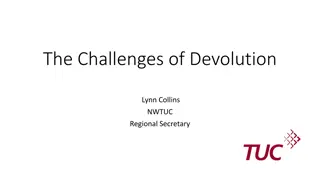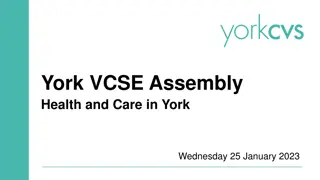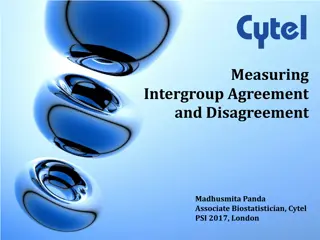Transformation of GM Workforce Through Devolution Agreement
The Greater Manchester Devolution Agreement, established in 2014, signifies a significant transformation for the NHS and social care services in the region. With aims to enhance workforce flexibility and adaptability, the agreement emphasizes the importance of a capable and culturally aligned workforce to deliver high-quality care. Decision-making processes have shifted to local and GM levels, ensuring better alignment with the needs of the population. This new approach is set to revolutionize the way healthcare services are delivered in Greater Manchester.
Download Presentation

Please find below an Image/Link to download the presentation.
The content on the website is provided AS IS for your information and personal use only. It may not be sold, licensed, or shared on other websites without obtaining consent from the author. Download presentation by click this link. If you encounter any issues during the download, it is possible that the publisher has removed the file from their server.
E N D
Presentation Transcript
Integrated Care Workforce Showcase Event Nov 2015 Yvonne Rogers Strategic HR/Workforce Lead
Greater Manchester: a snapshot picture GVA Gross Value Added LEP Local Enterprise Partnership 2
The background to GM Devolution Greater Manchester Devolution Agreement settled with Government in November 2014, building on GM Strategy development. Powers over areas such as transport, planning and housing and a new elected mayor. Ambition for 22 billion handed to GM. MoU Health and Social Care devolution signed February 2015: NHS England plus the 10 GM councils, 12 Clinical Commissioning Groups and NHS and Foundation Trusts MoU covers acute care, primary care, community services, mental health services, social care and public health. To take control of estimated budget of 6 billion each year from April 2016. Commitment in July 2015 budget to align the Spending Review process for health and social care to our Strategic Sustainability Plan From Oct 1st 2015 a new shadow Governance structure in place.
What will and wont - this mean for the NHS and social care Greater Manchester will remain within the NHS and social care systems and continue to uphold standards in national guidance and statutory duties in NHS Constitution and Mandate and for delivery of social care and public health services Decisions will continue to be made at the most appropriate level to the benefit of people in GM sometimes locally and sometimes at a GM level Organisations will work together to take decisions based on prioritising their people and their place From 1 April 2015 all decisions about GM nationally are taken with GM
What does this mean for the GM Workforce? Key Workforce Aims of the Devolution Agreement To ensure the workforce is liberated and flexible To ensure the workforce will work across both organisational and geographical boundaries To ensure the workforce is fit for purpose To ensure the workforce is sufficient and capable of providing high quality care at the point of need To ensure the workforce embraces the culture and values of devolved health and social care
Strategic Plan our vision- by Dec 15 Overarching plan Integrated document including detailed financials Resulting Components of the GM Model 1. A Social Movement for Change 2. Evidence Based Care across all Settings 3. Locality Based ICO/ACO operating a common prospectus 4. New Hospital Models 5. Health In novation Manchester 6. Single Estates Function 7. Single Workforce Transformation Plan 8. Single Information Governance and Data Sharing Agreement Locality plans (10) Set out local place view and key focus on integrated care approach; Consistent format and structure that can be aggregated Provider Collaboration Plans Set provider intentions and opportunities of how to deliver better care/productivity linked to estates requirements GM Workstreams Set out plans for GM-wide initiatives including provider reform/configuration and key enablers 8
Our Ambition By April 2016 we will take care of our own 6bn funding, and with this money we will make a number of significant investments so that by 2020 we will have 64,000 less people with chronic conditions 10% less visits to urgent care 6,000 less people being diagnosed with cancer 25,000 people with severe mental illnesses will benefit from better community-based care, reducing need for urgent services by 30% 18,000 children better supported by local services 700,000 people with chronic conditions, better able to manage their own health | 9
Opportunities for the Workforce Increased opportunity for multi-disciplinary working Increased opportunity for co-location of staff Opportunity to engage workforce in co-producing, supporting and implementation of local strategic vision and new models of care Improved information sharing Development of generic competencies to support integrated working Increased skill and capacity across the health & social care workforce Integrated health & social care workforce strategies, with more examples of joint commissioning Production of quality standards and best practice frameworks to ensure consistent working practices
Challenges for the Workforce The transition to integrated care and support Finding and keeping the right people with the right values Ensuring the culture fits Working across traditional role boundaries Lack of capacity to drive the agenda forward (competing pressure and demands on time/resources) Difficulties in sharing data across partner organisations Lack of engagement from key partners across Health, Social Care etc Duplication across the sectors Lack of clarity about the new ways of working Lack of leadership
Thank You Any Questions?
